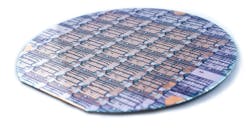GaN Technology Stretches Mixer Performance
Gallium-nitride (GaN) technology is generally associated with power amplifiers (PAs). However, GaN technology may now be a viable option to realize high-linearity passive mixers. In the tech brief, “Reach New Levels of Linearity in Passive Mixers with GaN Technology,” Custom MMIC explains why GaN technology possesses the capability to usher in a new breed of mixers. Three different GaN-based mixers are then presented.
The tech brief begins by explaining how many of today’s mixers are based on various gallium-arsenide (GaAs) processes, such as MESFET, pseudomorphic-high-electron-mobility-transistor (pHEMT), and heterojunction-bipolar-transistor (HBT) technologies. Moreover, third-order intercept point (IP3) is a parameter commonly used to classify mixers. Local-oscillator (LO) drive level is a key factor in terms of IP3 performance.
A new metric, linear efficiency, is defined as the difference between the IP3 and LO drive level of a mixer. The tech brief notes that many of today’s mixers have linear efficiencies ranging from 3 to 8 dB. System linearity requirements have increased over time, requiring mixers with greater IP3 levels. However, GaAs-based mixers would require extremely large LO drive levels to achieve the high IP3 levels that are being sought after, according to the document.
The desire for mixers with higher linearity prompted the investigation of GaN-based mixers. GaN processes can support two types of mixing elements: a two-terminal Schottky diode and a three-terminal field-effect transistor (FET). A typical GaN diode has a higher turn-on voltage than a typical GaAs pHEMT diode. Thus, mixers based on GaN diodes can achieve a higher IP3—at the expense of requiring a greater LO drive level. However, the document states that such mixers can achieve a higher linear efficiency than mixers based on GaAs pHEMT diodes.
The tech brief concludes by describing the individual design and performance of three different GaN-based mixers. The first one is an S-band three-terminal FET mixer, while the second is an X-band double-balanced diode-based mixer. The third is a Ku-band single-ended, cold FET mixer.
Custom MMIC, 300 Apollo Dr., Chelmsford, MA 01824; (978) 467-4290

